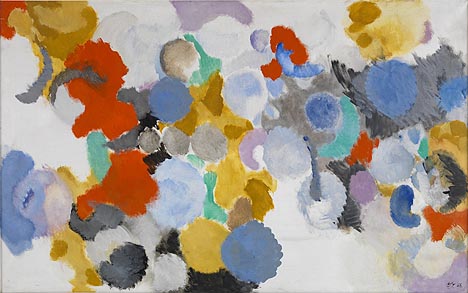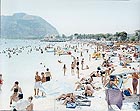
translated and summarized by: Liz Wollner-Grandville,
English summary June 28 - July 4
Museum Kunst Palast
Le grand geste!
10.04.10 bis 01.08.10
Ways to master the crisis
Düsseldorf’s Museum Kunst Palast is currently presenting 200 works in a veterans’-reunion of 60 artists – all of which have stayed young at heart, but some have fallen into oblivion. The both historic as well as stylistic analysis seems to be as just as tangled as the controlled random principle of colors and design processes, which, between the USA and Kassel - and celebrated at the documenta in 1959 - led to the term of Western Art: all of this was also an instrument during the Cold War: on the one hand the free gestures, on the other the propagandistically instrumented realism of the working-class heroes and the communist faces behind the Iron Curtain.
Abstract Expressionism, as a form of informal painting, received its official status through the documenta 1959 as well as through its major tour of European in 1958. “Abstraction as a global language” finally attained significance and established itself. And with the emergence of pop art, New York finally took the lead as the art capital of the world from the, until then, number one capital Paris.
The German Informal, this non-figurative form of art, was just about to react to the corpora cavernosa of Nazi art and the masters of German pubic hair, as well as to the cool right-angle work of the Bauhaus. Ultimately, the founding of innovative art groups such as “junger westen”, “zen 49”, or “Group 53” (the nucleus of the Dusseldorf art scene), introduced artists including Emil Schumacher, Willi Baumeister,
Fritz Winter, Peter Brüning, Hans Hartung, Ernst Wilhelm Nay, Gerhard
Hoehme, Fred Thieler or Bernard Schultze and Karl Otto Götz to the art world. But they never attained the same market-level as the Americans.
Doubtless, the exhibition gives preference to the Düsseldorf / German Informals – however, over the course of time, their visual effect wears off. Jackson Pollock’s large format incunabulum “Number 32” was taken from a neighboring art collection - but that did not help expand the perspective. The exhibition lacks works by key artists such as Mark Rothko, Barnett Newman, or Willem de Kooning: it is obvious that even this exhibition, which has a lot to offer and is highly recommendable, is hit by the current crisis-era.
On the other hand, you will find one of Emilio Vedova’s works from 1959 or Franz Kline’s “Painting Number 2” (1954), taking up De Kooning’s “Black Paintings”: superb! And a harmonious European-American dialog with Emil Schumacher’s “Documenta III” (1964) – more of this would have done the exhibition good.
Japanese artist Shiraga and Helen Frankenthaler (USA) offer a re-discovery and a new evaluation, something that is also achieved by the microcosms of the German artist Wol, with his close ties to the Paris-based “Ecole de Paris”. The calligraphic works created in 1961 by the Chinese artist Zao Wou-Ki were reanimated and Jean-Pierre Riopelle’s all-over mosaics clearly prove those wrong that describe his art as “arbitrary”.
Museum Kunst Palast
40479 Düsseldorf, Ehrenhof 4-5
www.museum-kunst-palast.de
Galerie White 8 Vienna
Mounty R.P. Zentara – Blue Blossom
28.05.10 – 17.07.10
Longing
Mounty R.P. Zentara presents his most recent light-objects at the Gallery White 8 under the poetic title of “Blue Blossom”: different coloured fluorescent tubes mounted in the frames of white varnished Gründerzeit-windows, with fanciful names such as Sky, Prairie, Rain, and Moon2. The presentation is small and compact, unpretentious and distinct. The windows are no longer in use and were given a new function by Zentara. Their damaged condition conveys their history, linking their past with the present, full of energy in the fluorescent light. A general expressiveness can be stressed in context with the titles, which draw upon their original elementary forms.
Such a moment might be immanent to this work, but it should not be interpreted as the artist’s intention. Instead, Zentara associates the colour combinations of the fluorescent light with the wonders of nature, which at the same time are the underlying inspiration for his art. The philosophy of recycling and utilizing an industrially manufactured product are the significant components – the combination of which is meant to point to the higher value of nature. Light is the central theme; the artwork can only be interpreted through light. If the tube is inactive the artwork is reduced to a concrete concept, an inactive sculpture in a close connection to its same-coloured background. The colourful light is the metaphor for nature – the exhibition is so to speak a blue blossom of our time.
By Margareta Sandhofer
Galerie White 8 Vienna
1010 Vienna, Zedlitzgasse 1
www.withe8.at
Manifesta 8
Global Dialogue with Fringes
The upcoming Manifesta 8 has the potential to become one of the most exciting projects of the art year 2010. Designed as a temporary network for always new, hitherto underexposed local contexts, the European Biennial of Contemporary Art centers on Murcia and Cartagena in Southern Spain this time. It is true that the last edition of the nomadic project situated along the transit axis between the Brenner and Verona saw only very few local references articulated – which the migration of workers informing life in the region or the clear sediments of Fascist modernity, for example, might certainly have provided. Nevertheless, the venture structured from Amsterdam has positioned itself in the leading group of biennials besides Istanbul and Berlin.
Manifesta aims at inscribing itself into local contexts with sustainable consequences. A clear programmatic shift is about to be implemented now. After its initial East-West rhetoric, Manifesta 8 intends to concentrate its “exploration of the fringes of Europe,” as the objective was occasionally described in former days, on the North-South axis between the coast of Spain and the countries of North Africa. A media cooperation with the Aljazeera news network has just been initiated. The fact that contemporary art is only sparsely present in the chosen region constitutes an additional challenge. As banners in public space indicate, the city of Murcia, for example, finds itself confronted with serious everyday problems such as its anything but satisfactory water supply, with large amounts of drinking water being siphoned off to adjacent tourism areas.
This is why the inner life of the already operating Manifesta machine strikes us as exciting even in the run-up. Three teams of curators are preparing their overall concept for the various venues such as an old artillery depot, a former post office, but also for the Murcia Fine Arts Museum and the Modern Art Museum in Cartagena, as well as for the San Antón prison in Cartagena with its remarkable pentagonal layout. Some of the curators seem to regard it is the actual challenge of this large-scale project to establish a target-aimed and collaborative practice between the three Manifesta teams in terms of contents.
To spell the names of all those involved correctly will not be easy for many reviewers this fall. There are three teams: the ERSTE Bank Foundation’s network transit.org with its focus on Eastern Europe comprising Zbynek Baladrán, Dóra Hegyi, Boris Ondreicka, and Georg Schöllhammer; the Chamber of Secrets group with Khaled Ramadan and Alfredo Cramerotti; and the Alexandria Contemporary Arts Forum with Bassam El Baroni and Jeremy Beaudry. Working on such a scale entails the activation of a transcontinentally functioning machine with an enormous detailed knowledge of local discourse on the one hand. On the other, the practice of collective curating has to result in processes permitting to formulate common questions concerning the different rhizomorphically related exhibition situations of the upcoming Manifesta 8 in Southern Spain in a pointed manner. This also finds its expression in the recent issue of the Manifesta journal under a headline suggesting itself: Collective Curating. Thus, Manifesta 8 has a clear opportunity to position itself as a very interesting outside-structured interior view of a region in dialogue with North Africa.
Manifesta8
Oct. 9, 2010 – Jan. 11 2011
Region of Murcia, South Spain
www.manifesta8.es
Brot Kunsthalle
Massimo Vitali – A touch of summer
24.06.10– 28.08.10
“I want it as complex as possible”
I remember how surprised I was about the aesthetic effect of a beach, packed with hundreds of half-naked (fat) bellies, when I first saw one of Massimo Vitali’s photographs – there is nothing more disgusting for me than the sight of half-naked overweight people.
He has been producing these huge recreation-society-landscape photographs for the past 15 years - taken at beaches, near mountain lakes, or riverbanks, and often put together as a diptych or triptych. The secret behind these large-format pictures rendering pin sharp details is the large size of the colour-negatives: 20x25cm or 28x25cm. The artist has never seen so many of his photos assembled in one exhibition, as the one currently shown at Ernst Hilger’s Brot Kunsthalle.
The viewer takes the position of a camera-lens and is an impartial observer of a socio-cultural phenomenon. Yet the distance is so large that the aesthetic principle dominates the documentary principle, and paradoxically, despite the detailed view of reality, the figurative ends up in a kind of abstraction: the sunshades, inflatable swimming gear and sports equipment turn into colour blotches on a pale-blue, beige, or green surface, and their random distribution – the self-organized chaos – turns into a compositional element. Viewed this way, Massimo Vitali’s images are a continuation of Georges Seurat’s “Bathers at Asnières” (1884) and “Sunday afternoon on the Island of La Grande Jatte” (1886) - but with other means.
…. Peculiar, how art captures the beginnings of the new trend of public bathing, and now – after the disaster of the last weeks – nearly its imminent end. No, oil-polluted beaches are not a topic for him, Vitali said. There would be too few people seen cleaning up - and that would not render a good photo.
By Renate Quehenberger
Brot Kunsthalle
1100 Vienna, Absberggasse 27
www.brothkunsthalle.com
Mehr Texte von translated and summarized by: Liz Wollner-Grandville


 Teilen
Teilen




